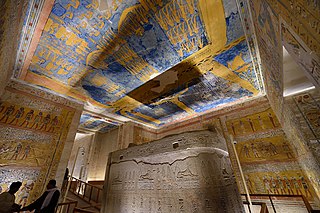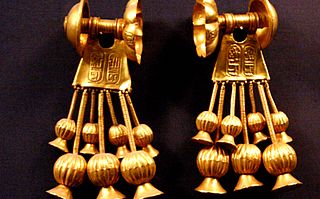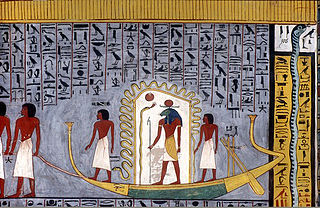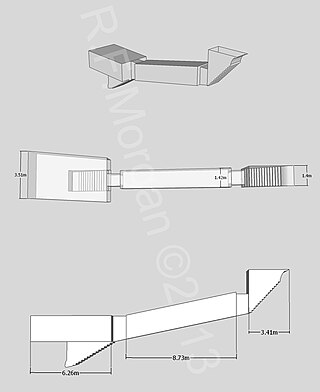
Meretseger was a Theban cobra-goddess in ancient Egyptian religion, in charge with guarding and protecting the vast Theban Necropolis — on the west bank of the Nile, in front of Thebes — and especially the heavily guarded Valley of the Kings. Her cult was typical of the New Kingdom of Egypt.

KV55 is a tomb in the Valley of the Kings in Egypt. It was discovered by Edward R. Ayrton in 1907 while he was working in the Valley for Theodore M. Davis. It has long been speculated, as well as much disputed, that the body found in this tomb was that of the famous king, Akhenaten, who moved the capital to Akhetaten. The results of genetic and other scientific tests published in February 2010 have confirmed that the person buried there was both the son of Amenhotep III and the father of Tutankhamun. Furthermore, the study established that the age of this person at the time of his death was consistent with that of Akhenaten, thereby making it almost certain that it is Akhenaten's body. However, a growing body of work soon began to appear to dispute the assessment of the age of the mummy and the identification of KV55 as Akhenaten.

The tomb of Tutankhamun, a pharaoh of the Eighteenth Dynasty of ancient Egypt, is located in the Valley of the Kings. The tomb, also known by its tomb number KV62, consists of four chambers and an entrance staircase and corridor. It is smaller and less extensively decorated than other Egyptian royal tombs of its time, and it probably originated as a tomb for a non-royal individual that was adapted for Tutankhamun's use after his premature death. Like other pharaohs, Tutankhamun was buried with a wide variety of funerary objects and personal possessions, such as coffins, furniture, clothing and jewelry, though in the unusually limited space these goods had to be densely packed. Robbers entered the tomb twice in the years immediately following the burial, but Tutankhamun's mummy and most of the burial goods remained intact. The tomb's low position, dug into the floor of the valley, allowed its entrance to be hidden by debris deposited by flooding and tomb construction. Thus, unlike other tombs in the valley, it was not stripped of its valuables during the Third Intermediate Period.

Tomb KV9 in Egypt's Valley of the Kings was originally constructed by Pharaoh Ramesses V. He was interred here, but his uncle, Ramesses VI, later reused the tomb as his own. The architectural layout is typical of the 20th Dynasty – the Ramesside period – and is much simpler than that of Ramesses III's tomb (KV11). The workmen accidentally broke into KV12 as they dug one of the corridors. In 2020, the Egyptian Tourism Authority released a full 3D model of the tomb with detailed photography, available online.

Tomb KV35 is the burial place of Amenhotep II, a pharaoh of the Eighteenth Dynasty of Egypt, in the Valley of the Kings in Luxor, Egypt. Later, it was used as a cache for other royal mummies. It was discovered by Victor Loret in March 1898.

Tomb KV2, found in the Valley of the Kings, is the tomb of Ramesses IV, and is located low in the main valley, between KV7 and KV1. It has been open since antiquity and contains a large amount of graffiti.

Tomb KV56, also known as the Gold Tomb, is a tomb located in the Valley of the Kings, near Luxor, Egypt. It was discovered by Edward R. Ayrton in January 1908 and contained what is thought to be the intact burial of a royal child from the late Nineteenth Dynasty. The burial and casket have disintegrated, leaving a thin layer of gold leaf and stucco in the original location. Most famously the tomb contained spectacular gold and silver jewellery including earrings, rings, silver bracelets with the names of Seti II and Twosret inscribed, and a pair of small silver gloves. The original occupant of this tomb is unknown but was possibly an Eighteenth Dynasty queen.

The area of the Valley of the Kings, in Luxor, Egypt, has been a major area of modern Egyptological exploration for the last two centuries. Before this, the area was a site for tourism in antiquity. This area illustrates the changes in the study of ancient Egypt, beginning as antiquity hunting and ending with the scientific excavation of the whole Theban Necropolis. Despite the exploration and investigation noted below, only eleven of the tombs have actually been completely recorded.

Tomb KV1, located in the Valley of the Kings in Egypt, was used for the burial of Pharaoh Ramesses VII of the Twentieth Dynasty. Although it has been open since antiquity, it was only properly investigated and cleared by Edwin Brock in 1984 and 1985. The single corridor tomb is located in Luxor's West Bank, and is small in comparison to other tombs of the Twentieth Dynasty.

Tomb KV3, located in Egypt's Valley of the Kings, was intended for the burial of an unidentified son of Pharaoh Ramesses III during the early part of the Twentieth Dynasty. It is similar in design to the "straight axis" tombs typical of this dynasty, and an ostracon written in hieratic script from the time of Ramesses III mentions the founding of a tomb for a royal prince, likely this tomb. The unfinished state of a couple of rooms in the tomb along with scant archeological evidence suggests that the tomb was never used. Some have suggested that it was originally intended for use by the prince regent who would succeed as Ramesses IV, and who started building his own tomb (KV2) soon after he came to the throne.

Tomb KV18, located in the Valley of the Kings in Egypt, was intended for the burial of Pharaoh Ramesses X of the Twentieth Dynasty; however, because it was apparently abandoned while still incomplete and since no funerary equipment was ever found there, it is uncertain whether it was actually used for his burial.

Tomb KV16 is located in the Valley of the Kings in Egypt. It was used for the burial of Pharaoh Ramesses I of the Nineteenth Dynasty. The burial place was discovered by Giovanni Belzoni in October 1817.

Tomb KV8, located in the Valley of the Kings, was used for the burial of Pharaoh Merenptah of Ancient Egypt's Nineteenth Dynasty.

Tomb KV26 is an ancient Egyptian tomb of the Eighteenth Dynasty located in Egypt's Valley of the Kings. It is located in a side valley leading to the tomb of Thutmose III (KV34). It was visited by the early Egyptologist James Burton in the 1820s or 1830s, and by Victor Loret in 1898. It was mapped in the 1980s by the Theban Mapping Project. The first documented excavation of the tomb was carried out in 2009 by the University of Basel's Kings' Valley Project. The tomb contained evidence of at least one burial and fragmented pottery and stone vessels of mid-Eighteenth Dynasty date but nothing is known about its occupant(s).

Tomb KV49, located in the Valley of the Kings, in Egypt is a typical Eighteenth Dynasty corridor tomb. It was the first of a series of tombs discovered in 1906 by Edward R. Ayrton in the course of his excavations on behalf of Theodore M. Davis. The tomb was abandoned before it was completed, and the work was halted as the stairwell in the single chamber was being cut. It was probably used as a store for royal linen, or was used as a mummy-restoration area in the later New Kingdom.
Tomb KV29 is an ancient Egyptian tomb in the Valley of the Kings, in the Theban Necropolis of Egypt. It is located near the mid-Eighteenth Dynasty tombs of Tiaa (KV32), Thutmose II or Merytre-Hatshepsut (KV42), and Thutmose III (KV34). The tomb was known since the 1830s and given the number KV29 in 1899 but no records of an earlier excavation exist. The entrance shaft was previously planned by the Theban Mapping Project in the 1990s. The tomb was first excavated by the University of Basel King's Valley Project in 2011. Excavation continued in 2016 but the rest of the tomb is filled with debris and its layout is unknown.
Tomb KV33 is an ancient Egyptian tomb in the Valley of the Kings in Egypt. It is located close to the tomb of Thutmose III, KV34. The tomb dates to the mid-Eighteenth Dynasty and was used for the burial of an unknown individual. The layout is simple, consisting of descending steps and a main chamber with two adjoining rooms. KV33 was discovered by Victor Loret in 1898. The small tomb was open to visitors in the early 1900s when it was described in a tourist guidebook. In modern times, a bench was built over the entrance. In 2012 the tomb was excavated for the first time by the University of Basel's Kings' Valley Project.

KV44 is an ancient Egyptian tomb in the Valley of the Kings near Luxor, Egypt. It was discovered and excavated by Howard Carter in 1901 and was re-examined in 1991 by Donald P. Ryan. The single chamber accessed by a shaft contained three intact Twenty-second Dynasty burials; the remains of seven mummies from the original interment were found within the fill. The original cutting of the tomb is dated to the Eighteenth Dynasty.

The Valley of the Kings, also known as the Valley of the Gates of the Kings, is an area in Egypt where, for a period of nearly 500 years from the Eighteenth Dynasty to the Twentieth Dynasty, rock-cut tombs were excavated for pharaohs and powerful nobles under the New Kingdom of ancient Egypt.
The majority of the 65 numbered tombs in the Valley of the Kings can be considered minor tombs, either because at present they have yielded little information or because the results of their investigation was only poorly recorded by their explorers, while some have received very little attention or were only cursorily noted. Most of these tombs are small, often only consisting of a single burial chamber accessed by means of a shaft or a staircase with a corridor or a series of corridors leading to the chamber, but some are larger, multiple chambered tombs. These minor tombs served various purposes, some were intended for burials of lesser royalty or for private burials, some contained animal burials and others apparently never received a primary burial. In many cases these tombs also served secondary functions and later intrusive material has been found related to these secondary activities. While some of these tombs have been open since antiquity, the majority were discovered in the 19th and early 20th centuries during the height of exploration in the valley.

















